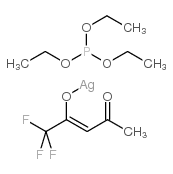783334-85-0
| Name | Triethoxyphosphine(trifluoroacetylacetonate)silver(I) |
|---|
| Molecular Formula | C11H19AgF3O5P |
|---|---|
| Molecular Weight | 427.10300 |
| Exact Mass | 425.99700 |
| PSA | 67.58000 |
| LogP | 3.82530 |
|
Section 1: Product Identification Chemical Name:Triethoxyphosphine(trifluoroacetylacetonate)silver(I), min. 98% CAS Registry Number:783334-85-0 Formula:C11H19AgF3O5P EINECS Number:none Chemical Family:metal-phosphine complex Synonym:none
Section 2: Composition and Information on Ingredients IngredientCAS NumberPercentACGIH (TWA)OSHA (PEL) Title compound783334-85-0100%0.01mg/m3(sl Ag)0.01mg/m3(sl Ag) Section 3: Hazards Identification Emergency Overview:Irritating to skin. May be irritating to eyes and respiratory system. Primary Routes of Exposure:Inhalation, skin Eye Contact:May cause slight to mild irritation of the eyes. Skin Contact:Causes slight to mild irritation of the skin. Contact with skin can lead to dark blotches (silver staining). Inhalation:May be irritating to the nose, mucous membranes and respiratory tract. Ingestion:No information available on the physiological effects of ingestion. May be harmful if swallowed. Acute Health Affects:Irritating to skin. May be irritating to eyes and respiratory system. Product contains fluorine which, under certain conditions of use, decomposition or metabolism, may generate Chronic Health Affects:fluoride ion causing nausea, vomiting, labored breathing, hypocalcaemia, deterioration of bone and tooth structure, kidney and liver damage. NTP:No IARC:No OSHA:No SECTION 4: First Aid Measures Immediately flush the eyes with copious amounts of water for at least 10-15 minutes. A victim may need Eye Exposure: assistance in keeping their eye lids open. Get immediate medical attention. Wash the affected area with water. Remove contaminated clothes if necessary. Seek medical assistance if Skin Exposure: irritation persists. Remove the victim to fresh air. Closely monitor the victim for signs of respiratory problems, such as difficulty Inhalation: in breathing, coughing, wheezing, or pain. In such cases seek immediate medical assistance. Seek medical attention immediately. Keep the victim calm. Give the victim water (only if conscious). Induce Ingestion: vomiting only if directed by medical personnel. SECTION 5: Fire Fighting Measures Flash Point:not applicable Autoignition Temperature:none Explosion Limits:none Extinguishing Medium:carbon dioxide, dry powder or foam If this product is involved in a fire, fire fighters should be equipped with a NIOSH approved positive pressure Special Fire Fighting Procedures: self-contained breathing apparatus and full protective clothing. Hazardous Combustion andIf involved in a fire this material may emit toxic organic fumes. Decomposion Products: Unusual Fire or Explosion Hazards: No unususal fire or explosion hazards. SECTION 6: Accidental Release Measures Spill and Leak Procedures:Small spills can be mixed with vermiculite or sodium carbonate and swept up. SECTION 7: Handling and Storage Handling and Storage:Store in a tightly sealed container. Keep in a cool, dry, well ventilated place. SECTION 8: Exposure Controls and Personal Protection Eye Protection:Always wear approved safety glasses when handling a chemical substance in the laboratory. Skin Protection:Wear protective clothing and gloves. Ventilation:Handle the material in an efficient fume hood. If ventilation is not available a respirator should be worn. The use of respirators requires a Respirator Respirator: Protection Program to be in compliance with 29 CFR 1910.134. Ventilation:Handle the material in an efficient fume hood. Additional Protection:No additional protection required. SECTION 9: Physical and Chemical Properties Color and Form:yellow solid Molecular Weight:427.10 Melting Point:no data Boiling Point:no data Vapor Pressure:no data Specific Gravity:no data Odor:no data Solubility in Water:insoluble SECTION 10: Stability and Reactivity Stability:air and moisture stable Hazardous Polymerization:no hazardous polymerization Conditions to Avoid:none Incompatibility:strong oxidizing agents, halogens and active metals Decomposition Products:carbon monoxide, carbon dioxide, organic vapors and silver oxides and carbonates SECTION 11: Toxicological Information RTECS Data:No information available in the RTECS files. Carcinogenic Effects:no data Mutagenic Effects:no data Tetratogenic Effects:no data SECTION 12: Ecological Information Ecological Information:No information available SECTION 13: Disposal Considerations Disposal:Dispose of according to local, state and federal regulations. SECTION 14: Transportation Shipping Name (CFR):Non-hazardous Hazard Class (CFR):NA Additional Hazard Class (CFR):NA Packaging Group (CFR):NA UN ID Number (CFR):NA Shipping Name (IATA):Non-hazardous Hazard Class (IATA):NA Additional Hazard Class (IATA):NA Packaging Group (IATA):NA UN ID Number (IATA):NA SECTION 15: Regulatory Information TSCA:Not listed in the TSCA inventory SARA (Title 313):Title compound: See category code N740 for reporting Second Ingredient:none SECTION 16 - ADDITIONAL INFORMATION N/A |
